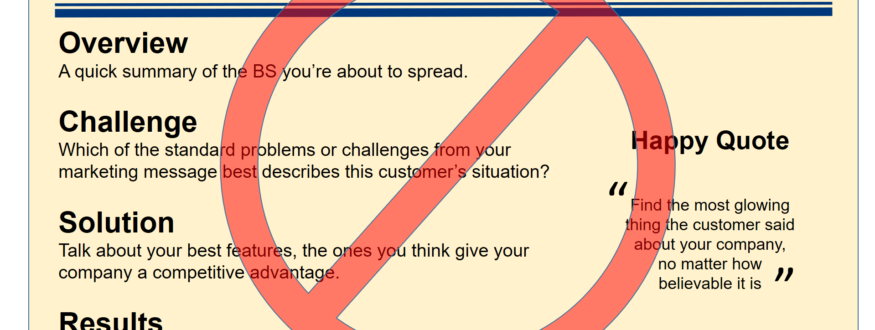It’s time to reinvent the classic customer case study
I’m guilty of it too, I’ve created over 100 of them in my career. Now it’s time to reinvent the classic case study. Why? The biggest reason is because buyers don’t want to read them, as they rarely address the specific, nagging, question, fear or doubt that the buyer has at the moment they are sent to her.
But before we get there, let’s talk about how they come about. I wish this was an exaggeration, but I’ve heard this from way too many marketers in the last year, so I know this is the norm. Sales reps are always asking marketing for more case studies. “I need a case study of a customer in manufacturing using product x”. So marketing obliges. And here’s how it usually goes.
The well-meaning marketer puts out a plea to the sales, services and support teams, “please, do you have any customers who are willing to do case studies?” And of course, there’s always a million reasons why it’s not a good time to ask a customer…”they have an issue right now”, “our champion there has left the company”, “I’m working on a $500K deal with them and I don’t want to disrupt it”, “we’re in renewal talks”, you know the reasons.
Every once in awhile, a customer raises their hand and says “Hey, I’m willing.” So then the stream of emails starts, trying to coordinate a time for the marketer to talk to the customer to make sure they are on board and to make arrangements. They bring in the professional writer who is a retired journalist and gifted storyteller to interview the customer, and the interview gets scheduled a month out because that’s the first date that works for the customer.
The writer does the interview and then assimilates everything he heard, and writes a first draft that doesn’t contain any of the raw emotion or real “story” of the anguish, pain, and eventual success achieved by the customer, instead it is full of the company’s marketing-speak that reinforces the company’s generic benefit points and promises.
And don’t even get me started on the format. OK, I’m already started, so every case study in the world (prove me wrong, someone) follows the same format…It’s a 2-4 page PDF, following the template in the picture above: Background, Challenge, Solution, Results, and the obligatory “happy quote” in the sidebar.
Now it takes another 3 weeks of back and forth, feedback from the client and edits by the writer, until the completely sanitized version is ready. Then it’s time to start the approval process. The customer just learned that in addition to her PR folks, she also has to run it by legal, and legal’s worried because the “happy quote” is an endorsement of your solution. So it gets further watered down.
You’ve got the approval, and the case study is posted to the sales portal, and included in the next “marketing newsletter to sales”, and the PDF is published to the website. Nothing happens with it until a sales rep asks someone in marketing, “Do we have any case studies for Manufacturing companies?” and the marketer emails the rep the PDF. The sales rep usually knows something about the biggest fear that is holding the manufacturing buyer back, but doesn’t read the case study, has no idea what it says, just sends it to the prospect as an email attachment and hopes something in there convinces the prospect to buy. Spaghetti against the wall.
What’s the end result? A PDF that is so generic, high-level, and full of marketing-speak that it doesn’t help buyers. Go from one company’s website to another in the same industry, and the case studies all sound the same. Here’s the test: take any of your case studies, put your competitor’s logo at the top, and does it still sound like a plausible story? All your competitors use the same format and use the same messaging. How is this helpful to a buyer?
It’s not. The real reason the classic case study is not helpful is because of what I wrote about in a prior post about how buyers want a crystal ball into what life is like as a customer. buyers have specific questions, fears, and doubts (QFDs) that arise at every point in their journey. They need those QFDs answered before they have the trust to move forward to the next step, where another QFD arises. Now that QFD needs to be answered. And so on.
It is time to retire the classic case study and replace it with the real, authentic customer voice, addressing the biggest objections, obstacles, and perceptions of your buyers. For example, every sales team struggles to create urgency so that deals move quickly. Imagine if you had the voice of several customers answering specific questions such as:
- “What was going on in our company that caused this initiative to become an urgent priority?”
- “How did you go about getting executive-level commitment to make this a top initiative for your company?”
- “What would have happened if you didn’t make a decision to move forward on this?”
We live and work in a trust economy. Buyers trust peers and colleagues more than your marketing and sales messages, and they view your traditional case studies, testimonials, and customer videos as advertisements.
Please prove me wrong, show me an example of a customer proof point that is helpful to a buyer.
